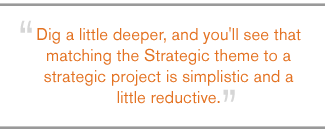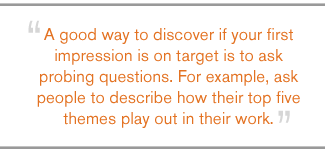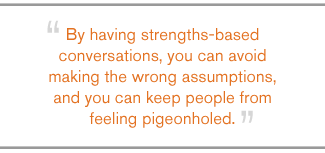Sometimes employees express to me the concern that if their managers learn their top talents and strengths, they (the employees) might end up pigeonholed. Here's what they mean: The Clifton StrengthsFinder (CSF) is an online instrument that measures a person's talents -- the ways in which he or she naturally thinks, behaves, or feels -- in 34 categories called "themes," then reveals the user's Signature Themes (his or her top five themes). For example, someone whose Signature Themes include Achiever, Activator, and Focus might fear that she'll be stereotyped as hard-charging and action-oriented, and as such, not appropriate for projects that require careful thought and deliberation.
 |
A related concern is that this person will be assigned specific responsibilities on a project or a team based solely on the results of her CSF assessment. I won't tell you that no one ever does this, but it's not a good idea. The themes of talent aren't labels that should be slapped on an employee.
Ron's story illustrates this point. Ron is an executive who had taken the CSF, and he'd begun managing his team using a strengths-based approach. By the time we met, each of his direct reports had also taken the CSF. As we were discussing the results, Ron said to me, "I'm working on a big strategic project. Should I put everyone on my team with the Strategic theme in their top five on the project team?"
At first glance, that seems sensible. But dig a little deeper, and you'll see that matching the Strategic theme to a strategic project is simplistic and a little reductive. There's a better approach.
First impressions versus supported impressions
It's possible to use CSF results in a situation like Ron's while avoiding pigeonholing people. But first, it's important to recognize that people have differing levels of awareness of other people's strengths and greatest talents.
One type of awareness is what I call the "first impression of talents." These assumptions are often shallow because they are based only on initial information. Often, they're fairly accurate, but they're not at all comprehensive.
The CSF can help make those first impressions much more sophisticated. For example, Ron always thought that Heather, one of his direct reports, was "quiet." She doesn't speak unless she's directly questioned, and Ron got the feeling that she didn't like talking in public.
After Heather took the CSF, Ron discovered that her Signature Themes were Learner, Input, Deliberative, Focus, and Responsibility. Because Heather didn't have the Strategic theme in her top five, Ron initially eliminated her from the pool of candidates for his project. However, Heather's CSF results suggested to Ron that she was perfectly willing to speak her mind; she just wasn't going to do it until she took in information, gave it some serious thought, and had something useful to say about next steps. Until then, she wasn't going to say much.
First impressions aren't necessarily wrong, but -- like Ron's initial impression of Heather -- they're not necessarily right, either. It's important to remain open to more information and avoid assuming that your first impression is a fact. Although the CSF will give you good clues about a person's talents, it's crucial to verify your assumptions.
This leads us to the next type of awareness -- what I call a "supported awareness of talents." This is simply your first impression of someone plus knowledge of that person's talents, supported by further discussions with the individual. Ron's first impression of Heather was that she was quiet; his second was that, like other people particularly talented in the Deliberative theme, she would mull over information and be thoughtful about next steps.
Ron followed up on his initial impression by talking with Heather about her talents and how she uses them. "Lots of people think of me as quiet," Heather said to Ron, "but I don't see myself that way. I like to gather information and think it through before I give my opinions. So I really appreciate it when others give me a little time to reply or ask me questions, because it makes me feel like they value what I contribute to the discussion."
This conversation confirmed Ron's initial impression of Heather, but it also helped him clarify it. He reached supported awareness of her talents only after he'd talked with her to determine whether his assumptions were valid.
A good way to discover if your first impression is on target is to ask probing questions. For example, ask people to describe how their top five themes play out in their work. Dig further by asking them to give examples of how their top themes affect their decision making, relationship building, and motivation.
 |
Don't use leading questions, however. That's just a way of confirming your assumptions, not eliciting authentic replies. Think about it: The response to "I see you as someone who needs to gather a good deal of information before making a decision. Is that correct?" will always be "yes," because who would say "no"? Don't tell people how they work -- ask them. (See sidebar "Discussing Strengths: Seven Probing Questions.")
You'll find that supported awareness of talents will often reinforce aspects of your first impression. The CSF will give you great clues, but it's important to have some in-depth conversations before you can confirm your assumptions.
Verifying your assumptions, though, isn't the only reason to talk with others about their talents. Conversations about strengths and the talents behind them can drive employee engagement. A Gallup survey explored what happens when a manager focuses on an employee's strengths, focuses on an employee's weaknesses, or ignores that employee. Gallup found that 55% of the employees who felt that their managers focused on their weaknesses were not engaged or were actively disengaged. (See "Strengths: The Next Generation" in the "See Also" area on this page.)
And studies in companies bear this out: In one company Gallup studied, research showed that among employees who didn't agree that their company was committed to building strengths, only 6% were engaged, and 52% were actively disengaged. This compares to 83% engaged and 0% actively disengaged among employees who strongly agreed that their company was committed to building strengths.
The very act of verifying your assumptions can have a positive effect. People see that you're interested in them, and they feel they have a voice in how their talents are applied. Conversations like these also offer a natural segue to discussing how you can use your talents to support one another and what this will mean to how you work together. In many cases, these conversations will lead to discussions about how you can work with others, based on their talents, to form complementary partnerships. (See "Debunking Strengths Myth #1" in the "See Also" area on this page.)
Putting it together
Let's go back to Ron. On the surface, it seemed like a good idea when he considered assigning the people who had Strategic as a top-five theme to his project. Instead of basing his thinking on first impressions, though, Ron needed to go deeper. Ron and I worked together and discovered a more effective way to proceed.
First, we defined the project more clearly by breaking it into smaller pieces. During this phase, we avoided using the theme names from the CSF in the description of project steps. This helped us define what the project needed to be a success.
Next, Ron distributed the project description to his team. He asked them to think about how they could contribute to the project based on their talents. Each person rank-ordered the parts of the project they wanted to work on. Then Ron talked with them individually about their thoughts and suggestions before he assigned responsibilities.
It may sound like a lot of work, but Ron found that it wasn't difficult. He told me that the typical issues that arise from new projects were all but nonexistent on this one because people understood the individual pieces of the project, and they could see how their talents could contribute to its success.
In fact, the team members did much of Ron's work for him. In the group meeting, they examined the project more closely than they would have if Ron hadn't broken it down into its essential parts. They gave each aspect a lot of thought and came to solid conclusions about their potential contributions. And they were more than happy to have a follow-up conversation with Ron about their talents. Ron used those conversations to put together an excellent team.
Did that team's engagement level increase? Yes, it did. Ron's employees felt that they were being involved in the process, their manager cared, their opinions counted, and they had a voice. And after the project got off the ground, each of them was working with his or her strengths -- and that does a lot for engagement.
 |
By having strengths-based conversations like these, you can avoid making the wrong assumptions, and you can keep people from feeling pigeonholed. The upfront investment of time and effort turns into increased engagement and gets things running smoothly. It's amazing what happens when people are given a voice and asked to bring the best of who they are to the situation at hand.
Just ask "Deliberative" Heather, whom Ron ended up inviting to join the project after initially bypassing her. "I need her," Ron said. "I overlooked her at first because she doesn't have the Strategic theme in her top five. But I hate to think what would have happened if the team didn't have her thoughtful voice of reason."
Discussing Strengths: Seven Probing QuestionsA good way to verify your first impressions of other people's talents is to ask probing questions, then discuss the responses. The questions below can help you get strengths conversations started in your organization. To deepen the discussions, ask people to offer specific examples of how they use their talents at work. Some example follow-up questions are also shown below.
|
